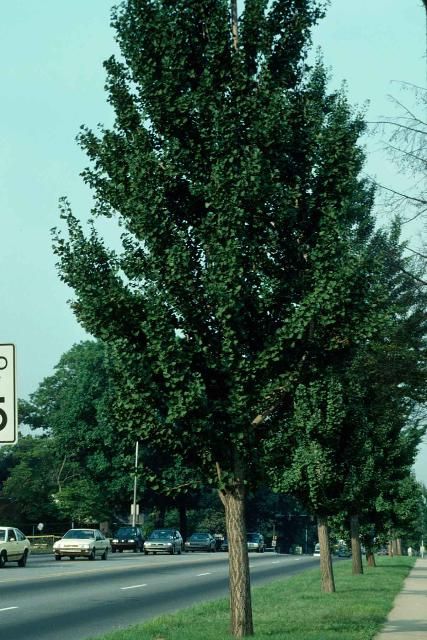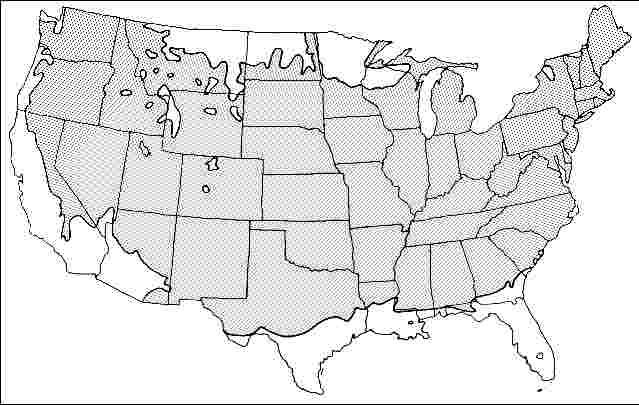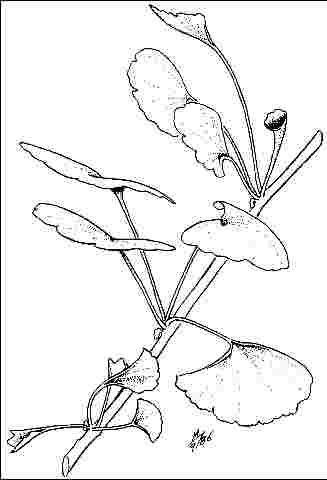Introduction
This male cultivar of Ginkgo is practically pest-free, resistant to storm damage, and casts light shade due to the narrow crown. It has a dense, fat columnar form growing to about 65 feet tall with a 15 to 20-foot-wide crown. It makes a durable street tree where there is limited vertical overhead space. Other narrow upright cultivars include `Fairmont' and `Fastigiata'. Ginkgo tolerates most soil, including compacted, and alkaline. The tree is easily transplanted and has a vivid yellow fall color which is second to none in brilliance, even in the south. However, leaves fall quickly and the fall color show is short.

Credit: Ed Gilman
General Information
Scientific name: Ginkgo biloba
Pronunciation: GINK-go bye-LOE-buh
Common name(s): 'Princeton Sentry' Maidenhair Tree, `Princeton Sentry' Ginkgo
Family: Ginkgoaceae
USDA hardiness zones: 3B through 8A (Fig. 2)
Origin: not native to North America
Invasive potential: little invasive potential
Uses: street without sidewalk; sidewalk cutout (tree pit); tree lawn > 6 ft wide; urban tolerant; highway median; Bonsai; tree lawn 4-6 feet wide
Availability: somewhat available, may have to go out of the region to find the tree

Description
Height: 50 to 65 feet
Spread: 15 to 20 feet
Crown uniformity: symmetrical
Crown shape: columnar, upright/erect
Crown density: dense
Growth rate: fast
Texture: medium
Foliage
Leaf arrangement: alternate (Fig. 3)
Leaf type: simple
Leaf margin: lobed
Leaf shape: fan-shaped
Leaf venation: parallel, palmate
Leaf type and persistence: deciduous
Leaf blade length: 2 to 4 inches
Leaf color: green
Fall color: yellow
Fall characteristic: showy

Flower
Flower color: green
Flower characteristics: not showy
Fruit
Fruit shape: no fruit
Fruit length: no fruit
Fruit covering: no fruit
Fruit color: no fruit
Fruit characteristics: no fruit
Trunk and Branches
Trunk/bark/branches: branches don't droop; showy; typically one trunk; thorns
Pruning requirement: little required
Breakage: resistant
Current year twig color: brown, gray
Current year twig thickness: medium, thick
Wood specific gravity: unknown
Culture
Light requirement: full sun, partial sun or partial shade
Soil tolerances: sand; loam; clay; acidic; alkaline; well-drained; occasionally wet
Drought tolerance: high
Aerosol salt tolerance: moderate
Other
Roots: not a problem
Winter interest: yes
Outstanding tree: yes
Ozone sensitivity: unknown
Verticillium wilt susceptibility: resistant
Pest resistance: free of serious pests and diseases
Use and Management
Ginkgo may grow extremely slow for several years after planting, but will then pick up and grow at a moderate rate, particularly if it receives an adequate supply of water and some fertilizer. But do not overwater or plant in a poorly-drained area. Very tolerant of urban soils and pollution, Ginkgo could be used more in USDA hardiness zone 7 but is not recommended in central and southern Texas or Oklahoma due to summer heat. Adapted for use as a street tree, even in confined soil spaces. Some early pruning to form one central leader and to eliminate vigorous upright branches is helpful.
There are several other cultivars: `Autumn Gold' - male, fruitless, bright gold fall color and rapid growth rate; `Fairmont' - upright, oval to pyramidal form; `Fastigiata' - male, fruitless, upright growth; `Laciniata' - leaf margins deeply divided; `Lakeview' - male, fruitless, compact broad conical form; `Mayfield' - male, upright fastigiate (columnar) growth; `Pendula' - pendent branches; `Santa Cruz' - umbrella-shaped, `Variegata' - variegated leaves.
Propagation is by seed or grafting males.
Pests and Diseases
This tree is pest-free and considered resistant to gypsy moth.
